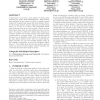BMVC
2000
15 years 1 months ago
2000
High-dimensional data, such as images represented as points in the space spanned by their pixel values, can often be described in a significantly smaller number of dimensions than...
112
click to vote
SDM
2004
SIAM
15 years 1 months ago
2004
SIAM
This paper presents a method of generating Mercer Kernels from an ensemble of probabilistic mixture models, where each mixture model is generated from a Bayesian mixture density e...
NIPS
2001
15 years 1 months ago
2001
In previous work on "transformed mixtures of Gaussians" and "transformed hidden Markov models", we showed how the EM algorithm in a discrete latent variable mo...
96
Voted
NIPS
2001
15 years 1 months ago
2001
Probabilistic mixture models are used for a broad range of data analysis tasks such as clustering, classification, predictive modeling, etc. Due to their inherent probabilistic na...
120
Voted
DICTA
2003
15 years 1 months ago
2003
For many applied problems in the context of clustering via mixture models, the estimates of the component means and covariance matrices can be affected by observations that are at...
101
Voted
DICTA
2003
15 years 1 months ago
2003
In this paper, we propose a robust method to estimate the fundamental matrix in the presence of outliers. The new method uses random minimum subsets as a search engine to find inli...
81
Voted
NIPS
2007
15 years 1 months ago
2007
Clustering is often formulated as the maximum likelihood estimation of a mixture model that explains the data. The EM algorithm widely used to solve the resulting optimization pro...
98
Voted
IJCAI
2007
15 years 1 months ago
2007
Nonparametric Bayesian mixture models, in particular Dirichlet process (DP) mixture models, have shown great promise for density estimation and data clustering. Given the size of ...
103
click to vote
INFOSCALE
2007
ACM
15 years 2 months ago
2007
ACM
In this paper, we propose a new method of citation data clustering for author name disambiguation. Most citation data appearing in the reference section of scientific papers incl...
125
Voted
ADMI
2010
Springer
15 years 2 months ago
2010
Springer
Abstract. We present a method for learning characteristic motion patterns of mobile agents. The method works on two levels. On the first level, it uses the expectation-maximization...





